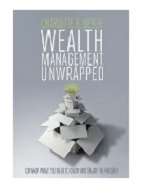 Wealth Management Unwrapped is Charlotte B. Beyer’s new book about how high-net-worth individuals ought to go about hiring, working with, and if necessary firing their financial advisers.
Wealth Management Unwrapped is Charlotte B. Beyer’s new book about how high-net-worth individuals ought to go about hiring, working with, and if necessary firing their financial advisers.
Most of the book is written to an audience of such HNW investors, although for the sake of mutual understanding the advisors themselves are invited along for the ride, and an 11 page appendix addresses them more specifically.
Beyer urges investor to ask questions of their would-be advisors, and she has many suggestions about what they should ask. They might ask about inflation, for example. Indeed, they should first ask themselves about inflation. What do they believe their dollars will be worth ten years, or fifteen years, down the road? Will it be akin to the 1970s? or to the almost steady-state dollar of recent years? Or might there be movement in the other direction, a deflation?
Thenthey should ask their advisers! It is important to know whether the people on opposite sides of the conference room table see this issue in similar terms or very differently.
Also, Beyer tells investors to be sure that “when your advisor does this math with you, you both are subtracting inflation, spending, taxes, and all fees….If an advisor is not eager to do the math find another who is.”
But of course, you don’t know – neither does any advisor not named Merlin – what the inflation rate will be next year, much less ten years down the road. Nor do you know how tax policy might change or which new disruptive technologies will emerge, etc. Beyer suggests that investors ask their advisors for the results of a Monte Carlo simulation, a graphic output of the software that traces portfolio returns over time given a variety of scenarios, including various plausible rates of inflation or deflation.
Why Not Go Passive?
Many writers have made the case, often quite eloquently, that the gains desired from active management of a portfolio – virtually anyone’s active management – are a snare. It is cheaper and safer to invest through broad based (passively managed) funds, perhaps exchange traded, perhaps not. Why? Because (a) alpha nets out to zero across the investing universe and (b) if you’re trying to beat the market, you’re among those who is paying for that zero.
Beyer considers that case a powerful one. But she also thinks there is a role for active management. After all, she asks us to consider investors who retired in 1999 and who (perhaps after listening to the sort of advice I summarized in the last paragraph) placed all their retirement money into passive equity vehicles. They were buying in at the “frothy top of the market,” and they were soon devastated by the dotcom crash. Surely they would have been better served by an advisor who might have talked them through asset allocation issues, keeping much of their portfolio out of equity and so away from the bull’s eye.
Hiring the right adviser, then, isn’t suckerdom. It can be insurance against suckerdom.
Are You My Mother?
About the search for that right advisor … Beyer reminds us, amusingly, of the classic (1960) children’s story, “Are You My Mother?” by Philip Day Eastman. In the story, a baby bird has been separated from its mother, and asks that plaintive titular question of a kitten, a hen, a dog, and a cow.
In the search for the right advisor, too, the desire to find the right fit has to be balanced against skepticism. This might be a dog rather than a maternal bird.
The baby bird’s search resembles what in the investment world is known as a beauty contest. Beyer lists three key points on how to conduct such a contest:
- Ask every firm interviewed precisely the same questions;
- Use numeric ratings during each interview;
- Incorporate the five Ps into the evaluation.
The five Ps are People, Process, Philosophy, Performance, and Phees. Give each interviewee a numeric score on these as well.
This doesn’t mean that the wise investor simply totals up the numbers at the end of all the interviews and hires the advisor with the highest sum. What it means, rather, is that the numbers remind the investor at the end of the process of what his/her reactions were during the interviews, in real time, and that even if they have since changed (especially if they have since changed) that can itself be a source of insight.
I will wrap up here. Those who are curious about what else Beyer has to say should go to the book for themselves and find out. They’ll find the experience rewarding.



